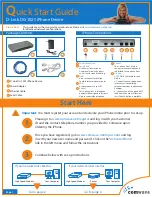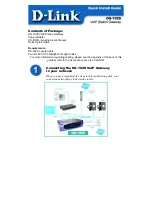
P-660R-D Series User’s Guide
81
Chapter 6 Network Address Translation (NAT) Screens
6.1.2 What NAT Does
In the simplest form, NAT changes the source IP address in a packet received from a
subscriber (the inside local address) to another (the inside global address) before forwarding
the packet to the WAN side. When the response comes back, NAT translates the destination
address (the inside global address) back to the inside local address before forwarding it to the
original inside host. Note that the IP address (either local or global) of an outside host is never
changed.
The global IP addresses for the inside hosts can be either static or dynamically assigned by the
ISP. In addition, you can designate servers, for example, a web server and a telnet server, on
your local network and make them accessible to the outside world. If you do not define any
servers (for Many-to-One and Many-to-Many Overload mapping – see
Table 24 on page 83
),
NAT offers the additional benefit of firewall protection. With no servers defined, your ZyXEL
Device filters out all incoming inquiries, thus preventing intruders from probing your network.
For more information on IP address translation, refer to
RFC 1631
,
The IP Network Address
Translator (NAT)
.
6.1.3 How NAT Works
Each packet has two addresses – a source address and a destination address. For outgoing
packets, the ILA (Inside Local Address) is the source address on the LAN, and the IGA (Inside
Global Address) is the source address on the WAN. For incoming packets, the ILA is the
destination address on the LAN, and the IGA is the destination address on the WAN. NAT
maps private (local) IP addresses to globally unique ones required for communication with
hosts on other networks. It replaces the original IP source address (and TCP or UDP source
port numbers for Many-to-One and Many-to-Many Overload NAT mapping) in each packet
and then forwards it to the Internet. The ZyXEL Device keeps track of the original addresses
and port numbers so incoming reply packets can have their original values restored. The
following figure illustrates this.
Figure 42
How NAT Works
Summary of Contents for P-660R-D Series
Page 1: ...P 660R D Series ADSL2 Router User s Guide Version 3 40 7 2006 Edition 1...
Page 2: ......
Page 10: ...P 660R D Series User s Guide 9 Customer Support...
Page 30: ...P 660R D Series User s Guide 29 Chapter 1 Getting To Know Your ZyXEL Device...
Page 66: ...P 660R D Series User s Guide 65 Chapter 4 WAN Setup...
Page 80: ...P 660R D Series User s Guide 79 Chapter 5 LAN Setup...
Page 96: ...P 660R D Series User s Guide 95 Chapter 7 Static Route...
Page 100: ...P 660R D Series User s Guide 99 Chapter 8 Dynamic DNS Setup...
Page 110: ...P 660R D Series User s Guide 109 Chapter 9 Remote Management Configuration...
Page 122: ...P 660R D Series User s Guide 121 Chapter 10 Universal Plug and Play UPnP...
Page 128: ...P 660R D Series User s Guide 127 Chapter 11 System...
Page 134: ...P 660R D Series User s Guide 133 Chapter 12 Tools...
Page 140: ...P 660R D Series User s Guide 139 Chapter 14 Troubleshooting...
Page 160: ...P 660R D Series User s Guide 141 Appendix C Wall mounting Instructions...
Page 184: ...P 660R D Series User s Guide 8 Appendix E IP Addresses and Subnetting...
Page 186: ...P 660R D Series User s Guide 2 Appendix F Command Interpreter...
Page 192: ...P 660R D Series User s Guide 4 Appendix H Splitters and Microfilters...
















































